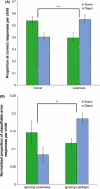Core geometry in perspective
- PMID: 25441089
- PMCID: PMC4529807
- DOI: 10.1111/desc.12266
Core geometry in perspective
Abstract
Research on animals, infants, children, and adults provides evidence that distinct cognitive systems underlie navigation and object recognition. Here we examine whether and how these systems interact when children interpret 2D edge-based perspectival line drawings of scenes and objects. Such drawings serve as symbols early in development, and they preserve scene and object geometry from canonical points of view. Young children show limits when using geometry both in non-symbolic tasks and in symbolic map tasks that present 3D contexts from unusual, unfamiliar points of view. When presented with the familiar viewpoints in perspectival line drawings, however, do children engage more integrated geometric representations? In three experiments, children successfully interpreted line drawings with respect to their depicted scene or object. Nevertheless, children recruited distinct processes when navigating based on the information in these drawings, and these processes depended on the context in which the drawings were presented. These results suggest that children are flexible but limited in using geometric information to form integrated representations of scenes and objects, even when interpreting spatial symbols that are highly familiar and faithful renditions of the visual world.
© 2014 John Wiley & Sons Ltd.
Figures





References
-
- Biederman I. Recognition-by-components: A theory of human image understanding. Psychological Review. 1987;94(2):115–147. - PubMed
-
- Biederman I, Cooper EE. Evidence for complete translational and reflectional invariance in visual object priming. Perception. 1991;20(5):585–93. - PubMed
-
- Biederman I, Ju G. Surface versus edge-based determinants of visual recognition. Cognitive psychology. 1988;20(1):38–64. - PubMed
-
- Biederman I, Kim JG. 17 000 years of depicting the junction of two smooth shapes. Perception. 2008;37(1):161–164. doi:10.1068/p590. - PubMed
-
- Bloom P, Markson L. Intention and analogy in children's naming of pictorial representations. Psychological Science. 1998;9(3):200–204.
Publication types
MeSH terms
Grants and funding
LinkOut - more resources
Full Text Sources
Other Literature Sources

